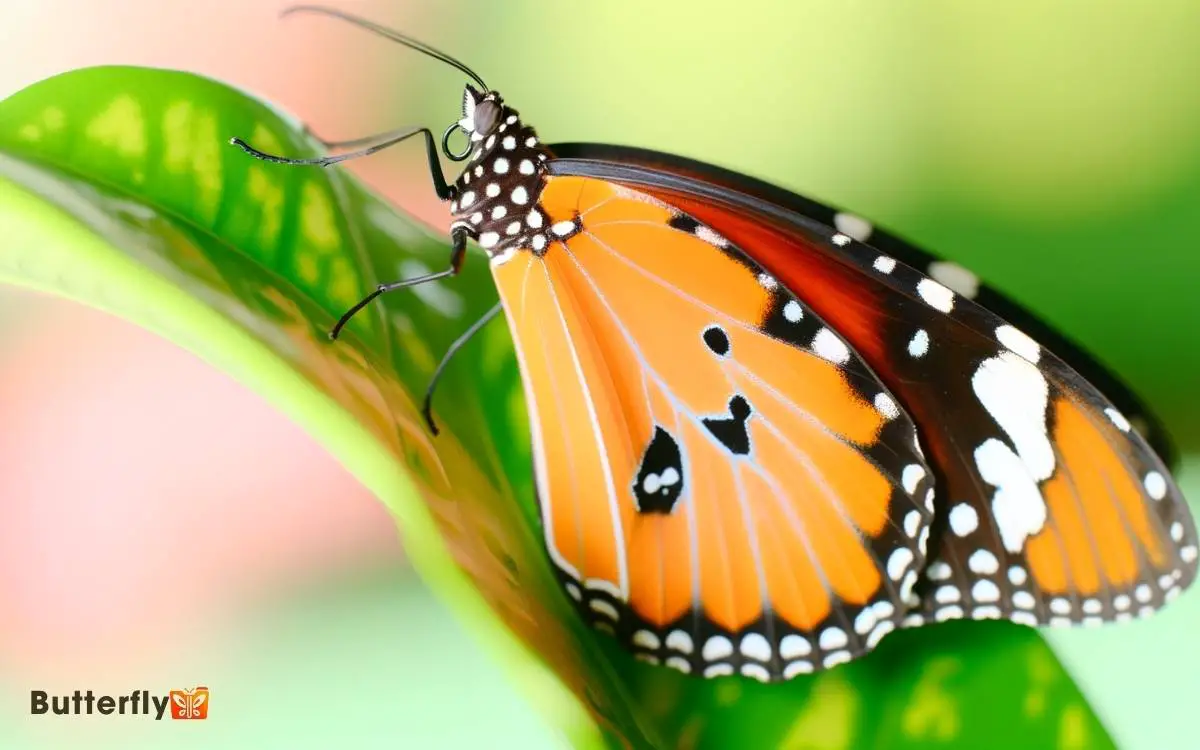Colors of a Monarch Butterfly: Exploring Nature’s Palette!
You’ll notice a monarch butterfly’s vibrant orange, black, and white coloration stems from biochemical processes and structural adaptations. The orange hue, rich in carotenoids, serves as a toxic warning to predators and indicates mate fitness.
Each color component contributes methodically to their survival and evolutionary success. Stay tuned to grasp the intricate details of these fascinating mechanisms.

Key Takeaways
The Science of Coloration
When you examine a monarch butterfly, you’ll notice its vibrant Coloration, which results from complex biochemical processes and structural adaptations.
The orange, black, and white hues are due to pigments and microscopic structures in the scales of its wings.
These scales contain carotenoids, which the butterfly ingests from milkweed. The pigments absorb certain wavelengths of light, reflecting others to create the striking colors you see.
Additionally, the arrangement of nanoscale ridges and grooves on the scales enhances these colors through light interference. This structural coloration serves multiple functions, including camouflage, thermoregulation, and signaling.
The Role of Orange
When you observe the vibrant orange of a monarch butterfly, you’re witnessing a multifaceted adaptation. This striking coloration serves as a warning signal to predators, aids in mate attraction, and contributes to camouflage and safety.
Warning Signal Function
The bright orange color of the monarch butterfly’s wings functions as a highly effective aposematic signal, warning potential predators of its toxicity. When you observe the vivid orange hue, you’re seeing a survival strategy in action.
This coloration indicates that the monarch has ingested toxic cardenolides from milkweed plants, making it unpalatable to birds and other predators.
| Feature | Function |
|---|---|
| Bright Orange Hue | Aposematic (warning signal) |
| Toxic Cardenolides | Defense against predators |
| Predator Response | Avoidance due to toxicity |
Attraction to Mates
While the bright orange hue of the monarch butterfly serves as a warning to predators, it also plays a pivotal role in attracting mates, signaling fitness and genetic quality.
You’ll observe that the intensity and vibrancy of the orange coloration are directly linked to the butterfly’s health and vigor.
Males with brighter, more saturated orange wings are often more successful in courtship. This phenomenon, known as sexual selection, guarantees that only the most robust individuals pass on their genes.
Studies have shown that females preferentially choose males with vivid coloring, as it indicates superior foraging ability and resistance to parasites.
Therefore, the orange coloration is a critical factor in the reproductive success of monarch butterflies, driving evolutionary benefits.
Camouflage and Safety
Understanding the dual role of the monarch’s orange coloration in both camouflage and safety reveals a complex interplay of evolutionary adaptations.
You’ll notice that the bright orange hue serves as a warning signal to predators, indicating the butterfly’s toxicity due to milkweed consumption. This phenomenon, known as aposematism, deters potential threats.
Simultaneously, in the monarch’s natural habitat, the orange coloration blends with the autumnal foliage, providing a form of seasonal camouflage.
When you observe their resting position, wings closed, the muted wing patterns further enhance concealment against predators.
Black Veins and Patterns
Amidst the vibrant orange wings of the monarch butterfly, intricate black veins and patterns create a striking contrast that aids in both flight mechanics and camouflage. These black veins serve as structural reinforcements, ensuring the wings maintain their shape during flight.
By examining the patterns, you can observe:
- Vein Density: The density of veins provides strength and flexibility.
- Pattern Symmetry: Symmetrical patterns contribute to aerodynamic efficiency.
- Camouflage: The black markings disrupt the wing outline, making it harder for predators to focus.
- Thermal Regulation: Darker veins absorb heat, aiding in thermoregulation.
These observations highlight the monarch’s evolutionary adaptations, enhancing both its survival and functionality. Understanding these features provides insight into the complexity and precision of natural design.
The Function of White Spots
Observing the white spots on a monarch butterfly’s wings reveals their crucial role in predator deterrence and species identification.
These white spots create a high-contrast pattern against the orange and black, which signals toxicity to potential predators. You’ll notice that this aposematic coloring is a clear warning sign, reducing the likelihood of predation.
Additionally, these spots facilitate species recognition among monarchs, ensuring effective mating and communication.
Through detailed observation, you’ll see that the arrangement of these spots isn’t random but rather methodically aligned to maximize their functional impact.
What Causes the Unique Color Variations in Monarch Butterflies?
The rare black and blue monarch butterfly gets its unique color variations from a genetic mutation. While most monarch butterflies have the iconic orange and black pattern, some individuals develop an unusual blue and black coloring due to a genetic anomaly. This makes them a striking sight in the wild.
Evolution of Monarch Colors
When you examine the evolutionary history of monarch butterfly colors, you’ll uncover a complex interplay of genetic mutations, natural selection, and environmental pressures shaping their distinctive hues.
The vibrant orange and black patterns aren’t random; they’ve evolved to maximize survival and reproductive success.
- Genetic Mutations: Variations in coloration often arise from random genetic mutations.
- Natural Selection: Predators tend to avoid brightly colored monarchs, associating their colors with toxicity.
- Environmental Pressures: Different habitats exert unique selective pressures, influencing color variations.
- Mating: Bright, distinct colors can attract mates, enhancing reproductive opportunities.
These factors have collectively sculpted the monarch’s iconic appearance, making it a striking example of evolutionary adaptation.
You can see how each element plays an essential role in the butterfly’s survival and proliferation.
Colors in Migration
During migration, the vibrant colors of monarch butterflies play an essential role in thermoregulation and predator avoidance.
You’ll notice that the orange and black hues absorb sunlight, allowing the butterflies to maintain body warmth during cooler temperatures. This important thermoregulatory function is vital for their long flights.
Additionally, the bright colors serve as a visual deterrent to predators. Monarchs are toxic due to cardiac glycosides ingested during their larval stage from milkweed plants. Predators associate the vivid coloration with this toxicity, reducing predation rates.
The patterning and intensity of these colors can also signal the butterfly’s health and fitness, influencing mating success. Therefore, color isn’t just aesthetic but integral to the monarch’s survival strategy during its long migratory journey.
Conclusion
As you explore the intricacies of a monarch butterfly’s coloration, you’ll uncover a masterpiece of evolutionary adaptation.
The vibrant orange warns predators of toxicity, while the black veins and patterns contribute to aerodynamics and mimicry. White spots aid in camouflage and mate recognition.
These colors aren’t just for show; they’re essential for survival and migration. By understanding these nuances, you appreciate the complex interplay of biology and evolution that paints this winged marvel.







Your point of view caught my eye and was very interesting. Thanks. I have a question for you.
Can you be more specific about the content of your article? After reading it, I still have some doubts. Hope you can help me.
Your article helped me a lot, is there any more related content? Thanks!
Thank you for your sharing. I am worried that I lack creative ideas. It is your article that makes me full of hope. Thank you. But, I have a question, can you help me?
Thanks for sharing. I read many of your blog posts, cool, your blog is very good.
Can you be more specific about the content of your article? After reading it, I still have some doubts. Hope you can help me. https://www.binance.com/es-MX/register?ref=JHQQKNKN
I don’t think the title of your article matches the content lol. Just kidding, mainly because I had some doubts after reading the article.
Your article helped me a lot, is there any more related content? Thanks!
Thank you for your sharing. I am worried that I lack creative ideas. It is your article that makes me full of hope. Thank you. But, I have a question, can you help me?
Your point of view caught my eye and was very interesting. Thanks. I have a question for you.
I don’t think the title of your article matches the content lol. Just kidding, mainly because I had some doubts after reading the article.
Thanks for sharing. I read many of your blog posts, cool, your blog is very good.
See what the users say, and consider the benefits supplied from the
ingredients to ensure taking this complement is the best choice in your fitness goals.
Pure steroid alternate options can be an effective part of a
program to push the envelope of efficiency and well being for these who search it.
They mix crops and herbal extracts that are thought to spice up testosterone,
improve human progress hormone, and speed up muscle repair
and synthesis. For a one-capsule answer for taking your bodybuilding to the following level, CrazyMass P-MB ELITE
is the greatest way to go.
Legal steroid alternate options provide a viable and safer choice for athletes and health
lovers seeking to enhance their physique and performance.
By understanding the components, managing expectations,
conducting analysis, and seeking skilled steering, people can navigate the world of legal steroid alternate options
with confidence. Most men have reported
elevated lean muscle mass, fast recovery time, and improved endurance.
Scott Brunner, the CEO of the Alliance for Pharmacy Compounding, an advocacy group for compounding
pharmacies, declined to touch upon the specific suits or firms.
Nonetheless, in an e mail to NPR, he defined that compounders solely produce drugs when a prescriber
sends a prescription. According to 1 complaint, Mochi allegedly switched its sufferers to
compounded tirzepatide with different additives, like niacinamide.
The criticism also alleges they switched patients over to totally
different doses than these provided by Eli Lilly. These adjustments have been made “a minimum of 5 instances in simply eight months,” alleges
the complaint, to allow Mochi to keep promoting compounded tirzepatide.
Eli Lilly filed lawsuits in opposition to compounding pharmacies earlier
this month. Now, it has turned its attention to telehealth corporations promoting compounded tirzepatide.
The most common alternative remedy for pain administration is prolotherapy.
Prolotherapy is a regenerative drugs injection to deal with musculoskeletal accidents and continual situations
like arthritis. Consisting of a protected, hyperosmotic resolution that stimulates local immune cells in an affected space, prolotherapy is actually the precise opposite of
cortisone. Arthritis, tendinitis, bursitis—if you have a ache situation that ends in “itis,”
it’s likely you’ve been provided cortisone treatments in the past.
Cortisone injections are sometimes one of the first
(and only) options provided by conventional docs.
Loss of strength, stamina, vigor, hair loss, a manifestation of osteoporosis, loss of memory
and an eventual drops of muscle and strength are primary symptoms
that may plague the human body. HBULK also helps to increase pink blood cell production which
finally ends up in vaster endurance during weight coaching and cardiovascular classes.
The appetite is stimulated as nicely, allowing the bodybuilder to absorb more meals for growing.
In Addition To of its functionality as a bulking agent, it’s also nice for its fat loss properties.
I even have been taking D-Bal MAX and have seen substantial enhancements in my
energy and vitality levels. Along with gaining muscle mass, I even have been able to sustain my power and power levels even throughout intense training sessions.
I am extremely glad with the results and suggest D-Bal MAX to
anyone looking for a secure and effective approach to build muscle and improve energy.
Whereas the tablet contains caffeine, it’s nothing that people who work out often have not skilled before.
As someone who values their well being and well-being, I highly recommend D-Bal Max as
one of the best authorized steroid options obtainable available on the market.
There are many different therapeutics available for injection which are both effective and secure.
These are homeopathic botanical substances that reduce inflammation and ache.
Far too often, these people achieve this earlier than considering the health dangers of SARM use.
Legal steroids are claimed to be a safer, legal different to conventional anabolic steroids.
Made with pure components, they might help you construct muscle, enhance power, and improve performance
with out dangerous unwanted facet effects. General, Prime Male is a wonderful selection for anybody seeking to boost their testosterone ranges naturally
and achieve maximum muscle growth. It provides a protected and efficient different to steroids, permitting you to succeed in your health objectives without compromising
your well being. Fortunately, there are authorized steroids
on the market that mimic the results of steroids
with no dangerous side effects. The better part about the best
authorized steroids for muscle growth is that they are 100% natural and provide unmistakably powerful results, making them the perfect supplements for each short-term and long-term use.
Now that we’ve established that cortisone itself isn’t a pain reliever,
it’s essential to verify out how these injections work for ache management.
When injected into a tissue, like a ligament within the knee
or tendon within the shoulder, cortisone does two issues.
First, it fully turns off or alters the immune system in that
area, so that it can’t react to normal stressors.
This highlights the potential of zinc as a natural different to anti-inflammatory drugs, providing a holistic approach to managing irritation with fewer
side effects. Long-term use of prednisone to manage continual inflammatory situations
may find yourself in the need for higher doses to handle signs,
rising the risk of extreme side effects.
Although prednisone is efficient in treating persistent pain, inflammation,
and associated symptoms, it could possibly also cause adverse results
starting from delicate discomfort to severe health issues.
We Have reviewed the most effective steroid alternate options on the market in 2025, and based on our finding, we now have decided that HGH-X2,
D-Bal, Clenbutrol, HBulk, and TestoPrime are our winners.
Every of those choices supplies a secure and authorized different
to illegal anabolic steroids. Not Like anabolic steroids, it’s just a mix of zinc,
magnesium, and vitamin B6. Which mixed can enhance
testosterone levels and aid in constructing lean muscle
mass. The distinctive mixture of nutritional vitamins and minerals can also help with the strengthening of bones by providing further vitamin D into
your system.
Many platforms supply it as a half of a semaglutide
on-line program, with individualized dosing, medical oversight,
and way of life teaching for higher outcomes. For weight reduction, semaglutide’s appetite-suppressing effects
make it simpler to stick to a calorie deficit, leading to steady, sustainable weight reduction over time.
This dual advantage of blood sugar control and urge for food regulation is why semaglutide is broadly
used for both diabetes and obesity management.
It is recommended to explore different solutions such as an old drug,
bodily therapy, exercise, weight loss, and a more healthy food regimen before taking prednisone.
This is actually what occurs when individuals purchase steroids illegally through the black market, as you aren’t buying from a reputable
firm and thus are not guaranteed to get what’s on the label.
We evaluated the value of every authorized steroid various to make sure it provides worth for
cash. We favored merchandise which might be competitively priced with out compromising on quality.
D-Bal Max is the closest legal alternative to Dianabol, promising muscle development without the
unwanted effects or authorized dangers. Testol 140 isn’t just one other
supplement; it’s a legalized SARM that works like
RAD 140, arguably the strongest SARM on the market. In my 20 years of expertise, I’ve
by no means seen something quite like it. It Is turn out to be the go-to alternative for so much
of bodybuilders who are looking for steroid-like results without the authorized risks or severe side effects.
References:
JBH News
Can you be more specific about the content of your article? After reading it, I still have some doubts. Hope you can help me.